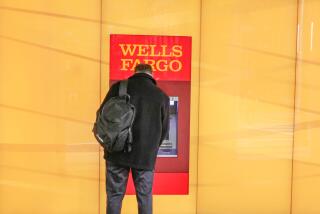Wells Fargo posts profit, surpasses Street
- Share via
Wells Fargo & Co. may have earned billions of dollars in the second quarter, easily surpassing Wall Street’s expectations, and raised more capital than federal regulators demanded, but investors zeroed in on the toll exacted on the bank by the flagging economy.
Like other big U.S. banks, Wells -- regarded by many analysts as the strongest of the bunch -- benefited in the April-to-June period from rising deposits and higher fees.
But the San Francisco company’s results, reported Wednesday, also contained causes for concern: uncollectable business and commercial real estate loans up 69%, write-offs of home mortgages up 94% and credit cards defaulting at an 11.6% annual rate.
“If you add up all of these write-downs, they start generating some big numbers,” said Bart Narter, a senior vice president at Celent, a financial consulting firm in Boston. “It may come back to bite Wells Fargo.”
That prospect helped send the company’s shares down 90 cents, or 3.6%, to $24.45.
Second-quarter revenue nearly doubled to $22.5 billion this year. That was mostly because of the acquisition, negotiated at the height of the financial crisis, of weaker rival Wachovia Corp. Still, the revenue figure outstripped analysts’ estimates of $20.5 billion, in part because lower interest rates early in the quarter stoked a mortgage refinancing boom.
Net income was $3.17 billion, or 57 cents a share, up 81% from $1.75 billion, or 53 cents, a year earlier. Analysts had anticipated just 34 cents a share.
But Wells said its credit-loss provisions for the quarter were $5.1 billion, up 69% from a year earlier and up 11% from the first quarter. Net charge-offs -- loans written off as uncollectable -- rose to 2.1% of average loans from 1.5% in the previous quarter.
Christopher Mutascio, a bank analyst at Stifel, Nicolaus & Co., said Wells could overcome the lending problems.
The company, he said, did “huge” business making home loans in the quarter and had much-higher-than-expected fees in its trust and investment and credit card operations. And the difference between the average interest rate it pays on deposits and the rate it earns on lending widened in the quarter, he said.
“The question now becomes: Does the company have the earnings power to absorb the deterioration?” Mutascio wrote in a note to investors. “We think the answer is yes.”
The debate about the outlook for Wells echoed that surrounding other large banks -- including Citigroup Inc., JPMorgan Chase & Co. and Bank of America Corp. -- that recently beat Wall Street earnings estimates thanks to asset sales and better investment banking results, even as loan quality deteriorated.
Analyst Joe Morford, who follows Wells Fargo for RBC Capital Markets, said the banks’ second-quarter credit losses have been no worse than anticipated in the government “stress tests” conducted this year. Wells and others have reported that some loan problems are worsening at a slower pace -- a sign, he said, of an eventual turnaround.
Narter rejects that as a reason for optimism, saying the economic outlook remains bleak. “All the consumer lenders I talk to are repeating the same thing -- they aren’t seeing a lot of creditworthy clients coming their way these days,” he said.
Average checking and passbook deposits at Wells rose 20% from the first quarter, giving the bank a cheap source of funds and new customers. “If you are lucky enough to retain your job, you probably want your money in the bank and not in the [stock] market these days,” Narter said.
Wells’ success in raising more than $14 billion in new capital raised the question of when it might repay the $25 billion it received last year from the U.S. Treasury. Wells Chief Executive John Stumpf said only that the payback would occur “in a shareholder-friendly way” at an unspecified date.
--
More to Read
Inside the business of entertainment
The Wide Shot brings you news, analysis and insights on everything from streaming wars to production — and what it all means for the future.
You may occasionally receive promotional content from the Los Angeles Times.










